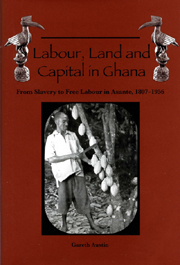Book contents
- Frontmatter
- Contents
- List of Illustrations
- List of Tables
- Preface
- Note on Names
- Maps
- Note on the Maps
- 1 Introduction
- Part I Context and Concepts
- Part II Social Relations of Production and Trade, 1807–1896: Absent and Imperfect Factor Markets
- Part III Slavery as Hobson's Choice: An Analysis of the Interaction of Markets and Coercion in Asante's Era of ‘Legitimate Commerce’, 1807–1896
- Part IV The Decline of Coercion in the Factor Markets of Colonial Asante: Cocoa and the Ending of Slavery, Pawnship and Corvée, 1896–c.1950
- Part V Social Relations of Production and Trade, 1908–1956: Towards Integrated Factor Markets?
- Part VI Freedom and Forest Rent, 1908–1956
- Abbreviations Used in the Notes
- Notes
- List of References
- Index
Part VI - Freedom and Forest Rent, 1908–1956
Published online by Cambridge University Press: 12 September 2012
- Frontmatter
- Contents
- List of Illustrations
- List of Tables
- Preface
- Note on Names
- Maps
- Note on the Maps
- 1 Introduction
- Part I Context and Concepts
- Part II Social Relations of Production and Trade, 1807–1896: Absent and Imperfect Factor Markets
- Part III Slavery as Hobson's Choice: An Analysis of the Interaction of Markets and Coercion in Asante's Era of ‘Legitimate Commerce’, 1807–1896
- Part IV The Decline of Coercion in the Factor Markets of Colonial Asante: Cocoa and the Ending of Slavery, Pawnship and Corvée, 1896–c.1950
- Part V Social Relations of Production and Trade, 1908–1956: Towards Integrated Factor Markets?
- Part VI Freedom and Forest Rent, 1908–1956
- Abbreviations Used in the Notes
- Notes
- List of References
- Index
Summary
This part seeks to explain the trends and patterns identified in Part Five and to explore their implications. The basic process in the making of a cocoa-based economy was the application of labour to land to create fixed capital. The organization of each of the next two chapters, on land and capital, follows the stages of the tree-farm cycle: from establishment, through maturity, to the consequences of the longevity of cocoa trees. In doing so, we examine the emergence of a recognisably contemporary ‘less-developed’ economy, and reflect on the problems involved for participants and observers. These include the long-running controversy over colonial ‘failure’ to introduce compulsory land titling, and the beginnings of a historic transition towards land scarcity: the latter creating possible opportunities for the capture of economic rents by those who control access to land, and the problem of finding rules to reconcile the interests of living individuals with those of society as a whole and of future generations. On the perennial controversy over agricultural indebtedness we inquire into the competitiveness of credit markets, and the social implications of the specific institutions involved. In this matrilineal society, we examine the dynamics of female cocoa-farming, and consider the legal and social struggles over the rights of divorced and widowed women, and their children, to shares in their husbands' cocoa farms. The shifts in property rights and factor markets had profound consequences for the ways in which chiefs sought to maintain their economic position within Asante society.
- Type
- Chapter
- Information
- Labour, Land and Capital in GhanaFrom Slavery to Free Labour in Asante, 1807–1956, pp. 323 - 324Publisher: Boydell & BrewerPrint publication year: 2005



